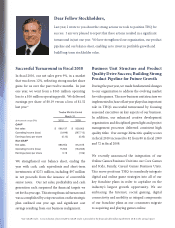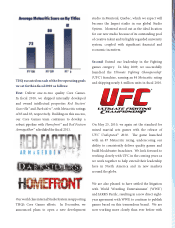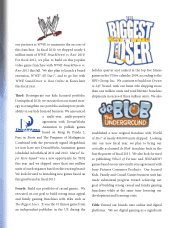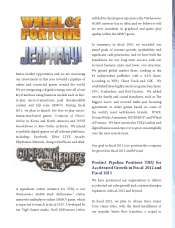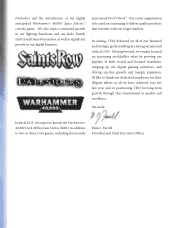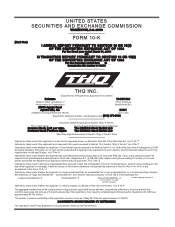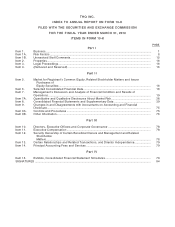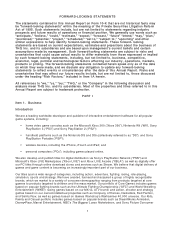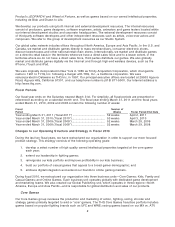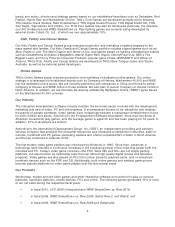THQ 2010 Annual Report Download - page 12
Download and view the complete annual report
Please find page 12 of the 2010 THQ annual report below. You can navigate through the pages in the report by either clicking on the pages listed below, or by using the keyword search tool below to find specific information within the annual report.
4
Our games are based on intellectual property that is either wholly-owned by us or licensed from third parties.
We develop our games using both internal development resources and external development resources
working for us pursuant to contractual agreements. Whether a game is developed internally or externally,
upon completion of development we extensively play-test each game, and if required, send the game to the
platform manufacturer (Microsoft, Nintendo or Sony) for its review and approval. Other than games we
release for PCs, for online play or for wireless devices, the platform manufacturers or their authorized vendors
manufacture our products for us. We then market and distribute our games for sale throughout the world.
Creating and Acquiring Our Intellec tual Property
Our business process begins with an idea. Inspiration for our interactive entertainment software comes from
many sources—from our internal studios, from our external studio partners, and from existing intellectual
properties that we either license or acquire. Historically, most of our titles have been based upon licensed
properties that have attained a high level of consumer recognition or acceptance. We have relationships with
many well-known licensors and create games based on certain properties they own or control. Licensors
generally do not grant exclusive output agreements for all of their properties with any one publisher and thus
our licenses are limited to certain of a licensor’s properties. Our current key licenses allow us to publish
games based on the following properties:
Licensor
Properties
Disney• Pixar
................................... “Ratatouille,” “WALL•E,” “Up,” and a future, yet to be announced title
DreamWorks Animation
............... “MegaMind,” “Kung Fu Panda: The Kaboom of Doom,” “Puss In Boots,”
and “The Penguins of Madagascar”
Games Workshop
.......................... Warhammer 40,000 universe
Marvel Enter tainment
................... “Super Hero Squad”
NB C
................................................... “The Biggest Loser”
Nic kelodeon
..................................... Kids 6-14 animated properties and related live action movies, including
“SpongeBob SquarePants” and “The Last Airbender”
Sony P ic tures Consumer
Products
........................................... “JEOPARDY!” and “Wheel of Fortune”
World Wrestling Enter tainment
. World Wrestling Entertainment content
Zuf fa, LLC
........................................ Ultimate Fighting Championship content
These intellectual property licenses generally grant us the exclusive use of the property for specified titles, on
specified platforms and for a specified license term. The licenses are of varying duration, and we pay
royalties to our property licensors generally based on our net sales of the title that includes the licensor’s
intellectual property. We typically advance payments against minimum guaranteed royalties over the license
term. Royalty rates are generally higher for properties with proven popularity and less perceived risk of
commercial failure.
In addition to licensed properties, we continue to create or acquire new intellectual properties that we own.
We refer to these properties as our “owned intellectual property[ies]”. Our owned intellectual property is
generally created by one of our development studios or by a third-party developer with whom we contract.
We have also acquired intellectual properties from other publishers or developers. The titles we create based
on our owned intellectual properties may contain certain licensed content, such as music or rights to use of a
name or object (such as a brand-name vehicle). In this case, we enter into a license agreement with the
content owner and pay either a fixed fee or royalty for the use of such content.
Developing Our Product s
We develop our products using both internal and external development resources. The internal resources
consist of producers, game designers, software engineers, artists, animators and game testers located within
our internal studios located throughout North America, in the United Kingdom and in Australia, and in our
corporate headquarters. The external development resources consist of third- party software developers and
other independent resources such as artists, voice-over actors and composers. We refer to this collective
group of development resources as our Studio System.
We make the decision as to which development resources to use based upon the creative and technical
challenges of the product, including whether the intellectual property being developed into a game is
licensed, an original concept that we created, or an original concept created by a third-party developer. Once
we determine where a product will be developed, our product development team oversees the internal or
external resources in its design, technical assessment and construction of each game.


